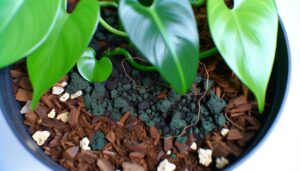Are There Monstera Deliciosa in the Wild? Yes!
Yes, Monstera deliciosa exists in the wild, primarily within the tropical rainforests of Central and South America. This species flourishes in humid, shaded understories, benefiting from consistent moisture and limited light penetration.
It is geographically widespread, found in countries such as Mexico, Panama, Colombia, and Ecuador. Monstera deliciosa grows both as a soil plant and an epiphyte, utilizing aerial roots to climb trees for sunlight access.
These structural adaptations facilitate its survival and proliferation. Conservation efforts are increasingly essential due to threats like deforestation and habitat destruction.
Learn more about the conservation strategies aiding its preservation.
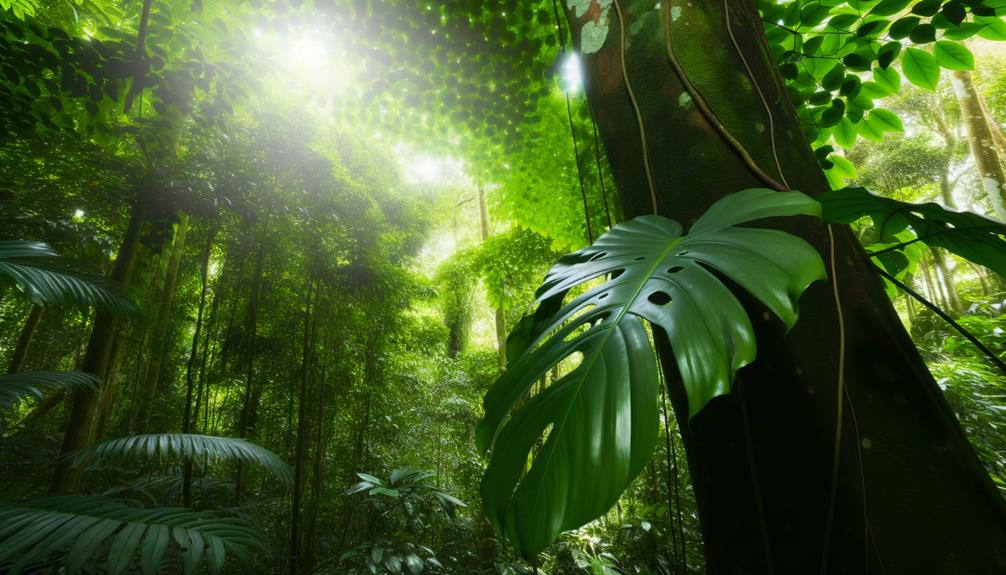
Key Takeaways
- Monstera Deliciosa originates from the tropical rainforests of Central America.
- It thrives in the humid, shaded understory of rainforests.
- The plant is found in countries like Mexico, Panama, Colombia, and Ecuador.
- Monstera Deliciosa faces threats from deforestation and habitat destruction.
- Conservation efforts are crucial for preserving wild populations of Monstera Deliciosa.
Origins of Monstera Deliciosa
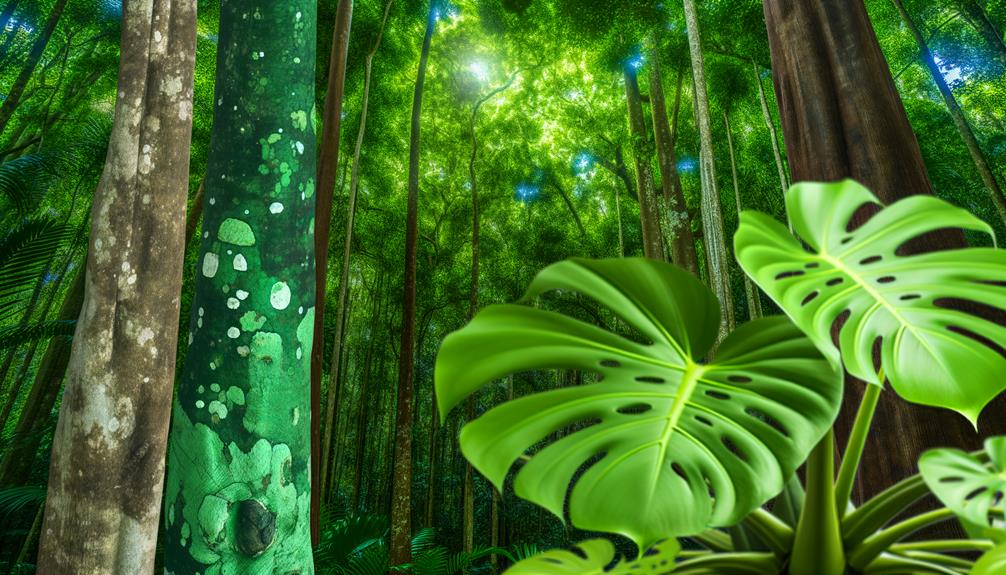
Monstera deliciosa, commonly known as the Swiss cheese plant, originates from the tropical rainforests of Central America, particularly southern Mexico and Panama. This species belongs to the Araceae family and is distinguished by its large, perforated leaves, which are an adaptation for increased light penetration and water drainage.
The plant exhibits a climbing growth habit facilitated by aerial roots that anchor to surrounding vegetation. Its inflorescence consists of a spadix surrounded by a spathe, typical of Araceae members.
Monstera deliciosa produces an edible fruit, known for its unique flavor reminiscent of a blend of pineapple and banana, hence its name ‘deliciosa.’
This fruit, however, requires careful handling due to the presence of calcium oxalate crystals when unripe.
Natural Habitat
Thriving in the humid, shaded understory of tropical rainforests, the natural habitat of Monstera deliciosa provides the ideal conditions for its growth and development. This environment offers consistent moisture levels, limited light penetration, and nutrient-rich soil, fostering the plant’s epiphytic nature.
Monstera deliciosa exhibits remarkable adaptability by climbing trees with its aerial roots, allowing it to access light and nutrients efficiently.
The high humidity supports its large, fenestrated leaves, which are believed to maximize light capture and reduce wind resistance. Moreover, the plant’s capacity to grow in both soil and as an epiphyte enhances its versatility within this ecosystem.
Consequently, these best conditions in tropical rainforests are essential for the robust growth and longevity of Monstera deliciosa.
Geographic Distribution

The natural habitat characteristics of tropical rainforests have facilitated the widespread geographic distribution of Monstera deliciosa across Central and South America. These regions encompass countries such as Mexico, Panama, Colombia, and Ecuador.
Monstera deliciosa thrives in the understory of these rainforests, where it benefits from high humidity, consistent temperatures, and rich, well-draining soil. This epiphytic plant often climbs trees using its aerial roots, accessing sunlight filtered through the dense canopy.
Observations indicate that Monstera deliciosa can also be found in secondary forests and disturbed areas, showcasing its adaptability. This distribution underscores the plant’s resilience and ecological versatility, allowing it to occupy various niches within its native range.
Climate Preferences
Monstera deliciosa thrives in tropical climates where temperatures typically range between 20°C and 30°C.
This species prefers high humidity levels, often exceeding 60%, to support its epiphytic growth habits.
Additionally, it exhibits best growth under filtered sunlight, mimicking the dappled light conditions of its native rainforest habitat.
Ideal Temperature Range
In their natural habitat, Monstera deliciosa plants exhibit ideal growth within a temperature range of 20 to 30 degrees Celsius, demonstrating a preference for warm and humid environments. This temperature range aligns with the tropical and subtropical regions where these plants are indigenous, primarily in the rainforests of Central America.
The species thrives in stable thermal conditions, avoiding extreme fluctuations. Temperatures below 10 degrees Celsius can impede growth and potentially cause physiological stress, while temperatures above 35 degrees Celsius may risk desiccation and cellular damage.
Maintaining an ideal thermal environment is essential for the plant’s physiological processes, including photosynthesis and respiration. This preference underscores the importance of consistent warmth for sustaining Monstera deliciosa in wild and cultivated settings alike.
Humidity Requirements
Perfect humidity levels for Monstera deliciosa range between 60% and 80%, reflecting their adaptation to the consistently moist atmosphere of tropical rainforests. This species thrives in environments where the air maintains a high moisture content, which is vital for best growth and physiological processes such as transpiration.
In their natural habitat, Monstera deliciosa benefits from regular rainfall and high ambient humidity, which prevent the foliage from desiccating. Inadequate humidity can lead to browning leaf edges and reduced vigor.
Thus, in cultivation outside their native regions, replicating these humidity conditions through methods like misting, humidifiers, or pebble trays is necessary.
Understanding the humidity requirements of Monstera deliciosa is essential for fostering their health and ensuring lush, vigorous growth.
Light Conditions
Thriving in the dappled light of tropical rainforests, Monstera deliciosa requires bright, indirect sunlight to mimic its natural understory environment. This species is adapted to the diffuse light filtered through the dense canopy, which prevents leaf scorching and promotes best photosynthesis.
Direct sunlight can cause photodamage, leading to chlorosis and necrosis of the leaves. In the wild, Monstera deliciosa exhibits phototropic behavior, orienting its large fenestrated leaves to maximize light capture.
Understanding these light conditions is essential for successful cultivation, ensuring that artificial environments replicate the nuanced interplay of shade and light found in its native habitats. This balance is vital for maintaining the plant’s physiological health and aesthetic appeal, aligning with its evolutionary adaptations.
Soil and Nutrients
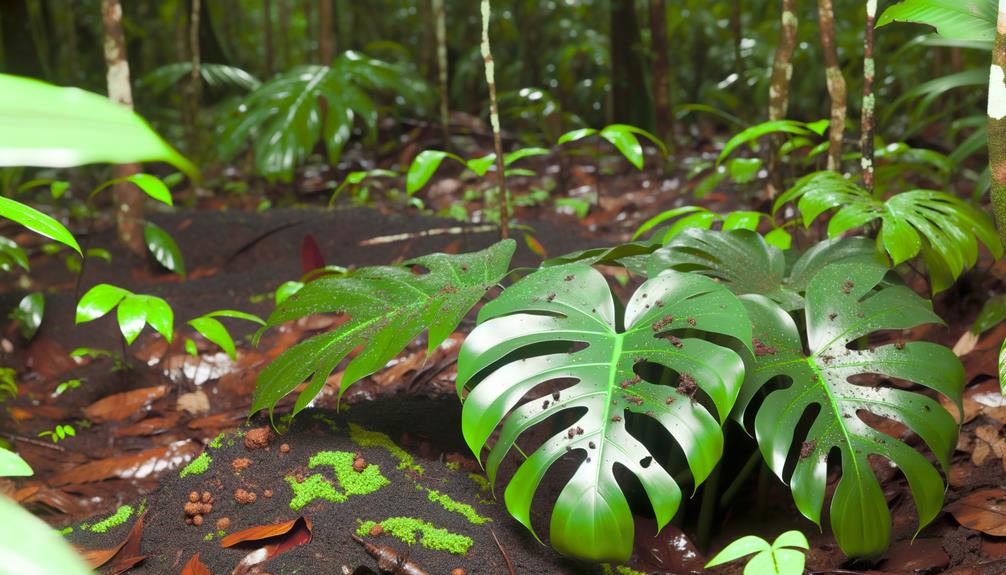
Understanding the specific soil composition and nutrient requirements of Monstera deliciosa is pivotal for its best growth in natural habitats. This species thrives in well-draining, loamy soil rich in organic matter. It benefits from a slightly acidic to neutral pH range, typically between 5.5 and 7.0.
Nutrient availability is essential; Monstera deliciosa absorbs macronutrients such as nitrogen, phosphorus, and potassium, along with micronutrients like magnesium and iron, to support vigorous growth and foliar health. In its native rainforests, decaying plant material provides a continuous supply of nutrients, enriching the soil.
Adequate moisture retention without waterlogging is crucial, as it ensures root aeration and prevents root rot. These factors collectively create optimal conditions for Monstera deliciosa in the wild.
Growth Patterns
Monstera deliciosa exhibits distinct growth patterns, characterized by its natural climbing tendencies facilitated by aerial roots.
Leaf size variations are prominent, often influenced by the plant’s maturation stage and light exposure.
Additionally, its ability to adapt to diverse environmental conditions underscores its resilience and versatility in wild habitats.
Natural Climbing Tendencies
In their natural habitat, Monstera deliciosa exhibits a unique climbing behavior facilitated by their aerial roots, which allow them to anchor onto trees and ascend toward light.
These specialized roots emerge from the stem, seeking out surfaces to grip, thereby enabling vertical growth. This epiphytic strategy not only aids in accessing sunlight but also minimizes competition for resources at ground level.
The plant’s remarkable ability to climb is complemented by its morphological adaptations, such as flexible stems and robust root systems, which provide stability and support.
Observations indicate that Monstera deliciosa can ascend significant heights in tropical forests, showcasing a dynamic interaction with its environment that optimizes light capture and enhances survival in densely vegetated ecosystems.
Leaf Size Variations
Leaf size variations in Monstera deliciosa are influenced by multiple factors including light availability, environmental conditions, and nutrient uptake. Observations reveal that the dimensions and morphology of Monstera leaves are not uniform, showcasing substantial diversity in the wild.
Key factors include:
- Light Availability: Higher light levels promote larger and more fenestrated leaves.
- Environmental Conditions: Humidity and temperature variations contribute to differential growth patterns.
- Nutrient Uptake: Access to essential minerals and organic matter significantly affects leaf size and health.
- Plant Age: Older plants tend to exhibit larger, more complex leaves compared to juvenile specimens.
These growth patterns reflect the plant’s adaptive strategies to optimize photosynthesis and resource acquisition in varying ecological niches.
Environmental Adaptations
The adaptation strategies of Monstera deliciosa in the wild showcase a remarkable ability to modify growth patterns in response to fluctuating environmental variables. This species is known for its epiphytic nature, allowing it to climb trees and access sunlight efficiently.
In low-light conditions, it exhibits phototropic growth, directing its stems towards available light sources. Monstera deliciosa also develops aerial roots, facilitating nutrient and water absorption from the atmosphere and surrounding debris. These adaptations ensure survival and peak growth in diverse habitats, from dense rainforests to more exposed areas.
| Environmental Factor | Adaptation Strategy | Resulting Growth Pattern |
|---|---|---|
| Light Availability | Phototropic Growth | Stems grow towards light sources |
| Nutrient Access | Aerial Roots | Enhanced nutrient absorption |
| Habitat Structure | Epiphytic Climbing | Increased sunlight exposure |
Local Ecosystems

Thriving in the tropical rainforests of Central and South America, Monstera deliciosa plays an important role in maintaining the biodiversity and ecological balance of these local ecosystems.
The plant contributes to its environment in several vital ways:
- Canopy Structure: Monstera deliciosa’s large leaves create microhabitats by providing shade and reducing temperature fluctuations.
- Soil Health: The plant’s roots help stabilize soil, preventing erosion and fostering nutrient cycling.
- Water Regulation: By retaining moisture, Monstera deliciosa aids in maintaining the rainforest’s humid microclimate.
- Habitat Creation: Its aerial roots and climbing nature offer refuge and support for various epiphytic plants and small animals.
This multifaceted contribution underscores the plant’s significance in sustaining the intricate web of life in tropical rainforests.
Coexisting Species
In the dense understory of tropical rainforests, Monstera deliciosa coexists with a myriad of species, forming intricate mutualistic relationships that enhance the ecological complexity of these environments.
This hemiepiphytic plant often climbs trees, benefiting from the structural support while providing habitats for various epiphytic organisms.
The large fenestrated leaves of Monstera deliciosa create microhabitats that harbor diverse arthropods and offer shade and moisture retention, aiding understory plants.
Additionally, the fruit attracts frugivores such as birds and mammals, which facilitate seed dispersal, promoting genetic diversity.
This dynamic interplay among species underscores the importance of Monstera deliciosa in maintaining the biodiversity and resilience of tropical rainforest ecosystems, showcasing its integral role within its native habitat.
Threats in the Wild

Monstera deliciosa faces significant challenges in its natural habitat, primarily due to anthropogenic habitat destruction that reduces the availability of suitable growing environments.
Additionally, the proliferation of invasive species presents a critical threat, often outcompeting Monstera deliciosa for essential resources such as light, water, and nutrients.
These factors collectively jeopardize the survival and propagation of this species in the wild.
Habitat Destruction Impact
Habitat destruction poses a vital threat to Monstera deliciosa, as deforestation and land conversion for agriculture drastically reduce its natural habitats. This species, native to tropical forests, relies on specific environmental conditions to thrive.
The impact of habitat destruction includes:
- Loss of biodiversity: Deforestation reduces the variety of plant and animal life, disrupting the ecosystem balance.
- Microclimate alteration: Changes in canopy cover affect humidity and temperature, essential for Monstera deliciosa.
- Soil degradation: Agricultural activities often lead to soil erosion and nutrient depletion, hampering plant growth.
- Fragmentation: Continuous habitats are broken into isolated patches, impeding genetic diversity and species resilience.
Understanding these impacts is necessary for developing effective conservation strategies to protect Monstera deliciosa in the wild.
Invasive Species Threat
The presence of invasive species poses a significant threat to the survival of Monstera deliciosa in its natural habitat. Invasive flora and fauna compete for essential resources such as light, nutrients, and space, often outcompeting native species.
For instance, aggressive vine species can smother Monstera deliciosa, inhibiting photosynthesis and growth. Additionally, invasive herbivores may feed on young Monstera plants, reducing their ability to mature and reproduce.
The introduction of non-native pathogens further exacerbates these challenges, causing diseases that native species have no resistance against.
Effective management strategies are imperative to mitigate these threats. Conservation efforts must focus on early detection, rapid response, and the restoration of native ecosystems to safeguard the genetic diversity and ecological role of Monstera deliciosa.
Conservation Efforts
Numerous conservation initiatives have been implemented to protect Monstera deliciosa’s natural habitats and guarantee the species’ long-term survival in the wild. These efforts are essential to preserving the biodiversity of tropical forests.
Key measures include:
- Habitat Restoration: Rehabilitating degraded areas to promote natural growth and sustain native flora, including Monstera deliciosa.
- Protected Areas: Establishing and managing reserves to shield vital ecosystems from deforestation and human encroachment.
- Research and Monitoring: Conducting scientific studies to understand population dynamics, genetic diversity, and ecological requirements.
- Community Engagement: Educating and involving local communities in sustainable practices and conservation strategies.
Such structured approaches ensure that Monstera deliciosa remains a thriving component of its native habitat, contributing to overall ecological balance.
Wild Vs. Cultivated Monstera
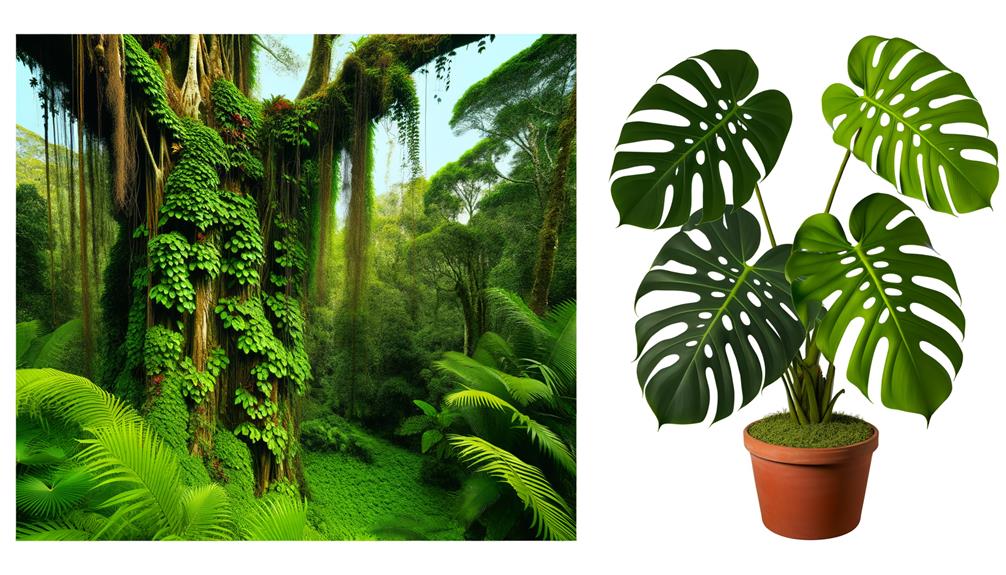
Understanding the differences between wild and cultivated Monstera deliciosa is essential to appreciating the impacts of conservation efforts on this species.
In their natural habitat, primarily the tropical rainforests of Central America, wild Monstera deliciosa exhibits robust growth, climbing trees to access sunlight while benefiting from the humid environment. These wild specimens often produce larger leaves and aerial roots compared to their cultivated counterparts.
Conversely, cultivated Monstera deliciosa, typically grown indoors or in controlled environments, exhibit adaptations to lower light levels and reduced humidity.
Their growth is often stunted, with smaller leaves and fewer aerial roots. Recognizing these distinctions is vital for developing effective conservation strategies and ensuring the preservation of genetic diversity within the species.
Conclusion
In summation, Monstera deliciosa, a plant of remarkable adaptability and resilience, thrives in its native tropical habitats, reminiscent of the lush and intricate rainforests described in mythological Edenic imagery.
The species’ natural distribution, climate preferences, and symbiotic relationships underscore its ecological importance. However, the encroaching threats from habitat destruction necessitate rigorous conservation efforts.
Understanding the dichotomy between wild and cultivated specimens provides critical insights into safeguarding this botanical marvel for future generations.


